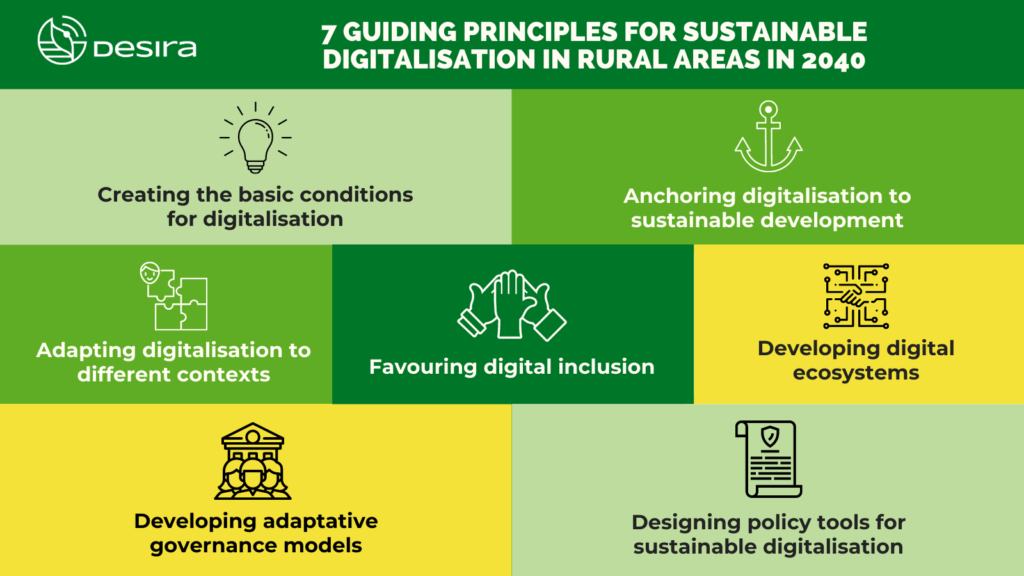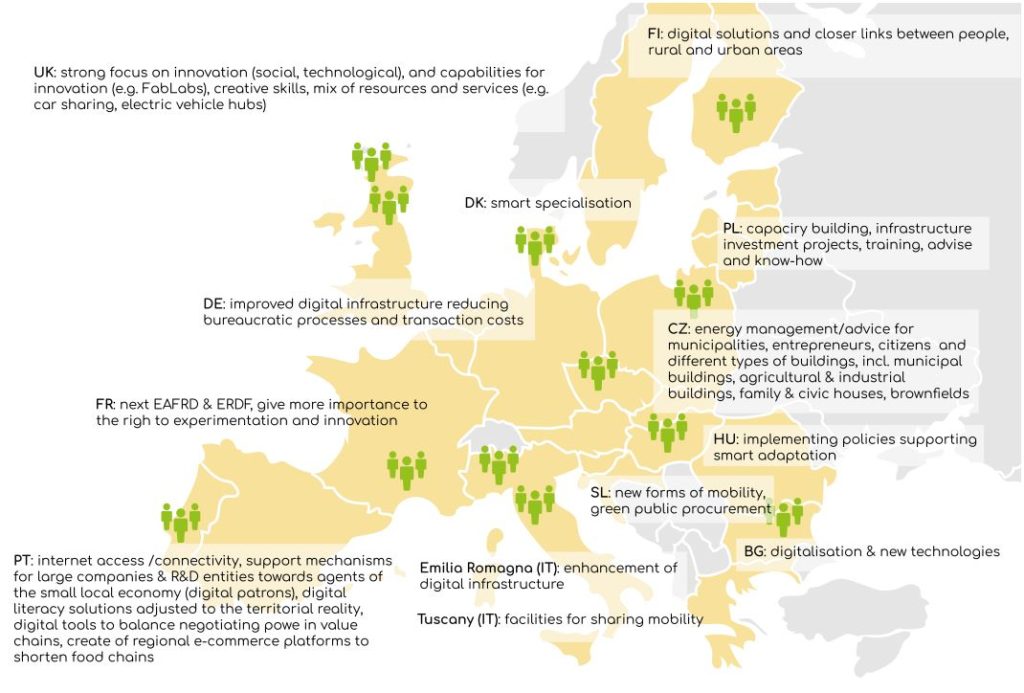On 30 June, the European Commission published the Communication on the Long-Term Vision for Rural Areas (LTVRA) up to 2040. The Vision identifies areas of action towards stronger, connected, resilient and prosperous rural areas and communities.
The Vision proposes a Rural Pact and a Rural Action Plan, to help rural communities and businesses reach their full potential in the coming decades. The EU Rural Action Plan will be articulated around four flagship initiatives:
- Creating an innovation ecosystem
- Boosting sustainable transport links and digitalisation
- Increasing environmental, climatic and social resilience
- Supporting economic diversification
Digitalisation has a prominent role in the future of rural areas, as a mega trend already affecting agriculture, forestry and the life of rural citizens across Europe. The second flagship initiative focuses on sustainable digitalisation. It put forward an integrated set of actions to boost the sustainable digital transformation of rural areas, by closing the digital gap, encouraging the use of digital technologies, providing the digital skills needed to make the most out of them, and measuring progress through indicators – the Digital Rural Index.
The Communication says that “digital infrastructure is an essential enabler for rural areas to contribute to and make the most of the digital transition“, and “the development of digital capacities in rural areas will improve their attractiveness.”
Several Horizon 2020 projects have contributed to the EU long-term vision. Both SHERPA and DESIRA mentioned digitalisation specifically.
What was DESIRA’s contribution to the EU?
DESIRA’s contribution takes the form of three documents that reflect on how digital technologies can contribute to build desirable futures for rural areas by 2040 and provide examples on the application of key technologies nowadays. Furthermore, a fourth document elaborating recommendations to be considered in the future rural vision, and highlighting the guiding principles for sustainable digitalisation proposed by the experts of the Rural Digitalisation Forum (RDF).

The H2020 project, DESIRA, organised on 30 June 2021, a webinar on ‘Boosting sustainable digitalisation in agriculture, forestry and rural areas by 2040’ under the scope of the RDF.
In this webinar, members of the forum and other interested rural stakeholders came together to get a common understanding of the role of digitalisation in the EU Long-Term Vision for Rural Areas and reflect on the recommendations produced by the Rural Digitalisation Forum to boost sustainable digitalisation of agriculture, forestry and rural areas. In addition, participants outlined the main challenges and opportunities for the digital transformation:
Challenges
- Poor access to digital connectivity and high-quality internet infrastructure, and low digital skills of rural citizens and businesses.
- The cost to access, design and deploy digital technologies.
- Low motivation and lack of capacities of local actors to participate and lead digital transformation processes at local level.
Opportunities
- Access to markets and opportunities for new business models.
- Enhance access to services.
- Enhance productivity and resource efficiency.
- Enable community-led innovation.
Participants also highlighted the policy support needed on the ground to ensure sustainable digitalisation:
- Set up a holistic framework of targets for rural digitalisation.
- Ensure that policies supporting digitalisation do not trigger or widen the rural-rural divide.
- Policies should support digitalisation, but not at any cost.
- Digital infrastructure and digital skills are the preconditions for digitalisation.
- Support is needed for local cooperation in digitalisation in a variety of rural fields.
All the presentations, background documents and outcomes of the webinar are available on DESIRA website.
How did SHERPA MAPs consider digitalisation in their desired visions for 2040?
The SHERPA Position Paper on the Long-Term Vision for Rural Areas (LTVRA) contributed to the debate on the Vision with insights from 20 Multi-Actor Platforms (MAPs). The MAPs identified their desired visions for 2040, the enabling factors to achieve those visions, the challenges to overcome and the opportunities to be seized.
Most SHERPA MAPs identified the rise of digitalisation and smart ruralities as one of the most valuable enablers. For example, the Danish MAP stated that the digital transition can help with service provision, job creation, and the development of new digital products. The Slovenian MAP highlighted how digitalisation can support the creation of new ways of working. This was also observed by the Hungarian MAP, which indicates that digitalisation will fundamentally change the way rural areas operate, economically, environmentally, and socially. It specifically identified robotisation in agriculture as an opportunity for rural territories that flows from the increase in digitalisation.
The Italian MAP in Tuscany highlighted that digitalisation is meant as an instrument to achieve improved access to health services, veterinary services, efficient agriculture, smart working, food supply chains organisation and sustainability, industrial chain efficiency, rural-urban connection and technological innovation.

Read more about the SHERPA MAPs’ Position Papers and their desired visions for rural areas in 2040.
